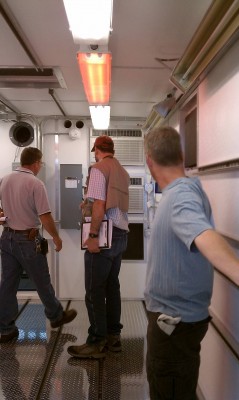
In a key milestone for the user facility, customized containers for ARM’s new aerosol observing systems (AOS) passed acceptance testing in mid-July. Stephen Springston, a scientist at Brookhaven National Laboratory and leader of the AOS development effort, visited Maloy Mobile Storage in Albuquerque, New Mexico, to inspect and approve the containers, which were customized from the standard 20-foot shipping containers. Because of additional modifications to support marine research capabilities of the second ARM Mobile Facility (AMF2), he was joined there by Brad Orr and Mike Ritsche, AMF2 site manager and assistant manager, respectively, from Argonne National Laboratory.
Since 1996, ARM has operated an AOS at its Southern Great Plains site in Oklahoma. It began collecting AOS data from scientific partners at the North Slope of Alaska site in Barrow in 1998, followed by the ARM Mobile Facility when it began operating in 2005. With funds from the American Recovery and Reinvestment Act of 2009, one of the new AOSs currently being integrated at Brookhaven is targeted for deployment at the ARM site in Darwin, Australia; another with the AMF2; and the third as a stand-alone mobile system comprised of separate 20-ft containers; one for aerosol and one for chemistry measurements.
Critical reviews during the acceptance testing ensured that the various container modifications met the agreed-upon design criteria: overall dimensions, cutouts and openings in the correct locations, proper materials, functionality, labeling, and general fit and finish. Upon acceptance, the AOS containers for the AMF2 were immediately shipped to Brookhaven where instrumentation will be installed and integrated. The aerosol and chemistry containers arrived soon after. See more photos in ARM’s Recovery Act image set.

